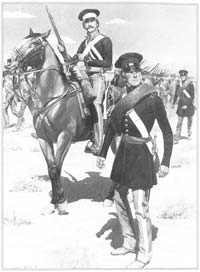A Call to Arms
Life in the U.S. Army
by James M. McCaffrey
 At the outbreak of war with Mexico the U.S. Army had only 8,600 officers and men, and almost half were assigned to frontier defense. In addition, more than thirty years had elapsed since the last war, and, except for those with experience fighting Indians, most of the soldiers had no combat experience. In response to the manpower shortage Congress authorized the president to call up 50,000 volunteers, who, after receiving a bare minimum of training, left for Mexico.
At the outbreak of war with Mexico the U.S. Army had only 8,600 officers and men, and almost half were assigned to frontier defense. In addition, more than thirty years had elapsed since the last war, and, except for those with experience fighting Indians, most of the soldiers had no combat experience. In response to the manpower shortage Congress authorized the president to call up 50,000 volunteers, who, after receiving a bare minimum of training, left for Mexico.
These additional troops were necessary for victory, but even though they were subject to the same regulations as those in the regular army their arrival caused friction with the regulars. During peace time, many saw the army as simply a place of refuge for those men who were unable to earn an honest living anywhere else. Although most of the regular officers were professionally educated, the enlisted men came from the low end of the socioeconomic ladder; approximately 40 percent were immigrants and a third of them were illiterate. Now, suddenly, it was fashionable to be in the army, and the regulars resented these newcomers for their absence of training and their appalling lack of discipline.
The volunteers quickly learned that soldiering was not all flag waving and martial glory. The food was often bad, the housing primitive, and the threat of disease always present. The soldier's basic ration consisted of beef or pork, hard bread (or flour or cornmeal with which to bake bread), peas, beans, or rice, and a little salt, sugar, and coffee as available. Each member of a squad took his turn preparing the food. Often the various articles were put into a camp kettle and boiled for hours into an easily digestible soup. There were ways to supplement this meager fare. Some men sampled the local cuisine, but many found it too spicy. Others patronized civilian sutlers who set up shop wherever the army was. Many raided local gardens and orchards, although army regulations strictly forbade all uncompensated foraging. The volunteers soon earned an unsavory reputation for this practice.
Upon arrival in Mexico, most of the troops lived in canvas tents. These simple affairs, each designed to accommodate six men and their bedrolls, offered far less protection against the wind and rain than even the rudest log cabins back home. As the war progressed and U.S. forces occupied towns, Mexican government buildings served as barracks. Yellow fever, malaria, dysentery, smallpox, measles, and various other diseases prevalent in Mexico were a constant scourge to the U.S. soldiers and killed far more than did Mexican bullets. The lack of attention to hygiene exhibited by many of the volunteers left them particularly susceptible to illness. Treatment of the sick and wounded in army hospitals was probably comparable to what was available in the United States. Army doctors were, on average, as capable as their civilian counterparts, but the general state of medical knowledge was such that treatments offered were not always beneficial to the patient. When the overworked surgeons encountered a wounded soldier with a limb shattered by a heavy musket ball, they often did not have time to do mud more than amputate it quickly before moving on to the next patient.
On the march, the U.S. soldier traveled as lightly as possible, since every ounce of extra weight made it that much more difficult to continue in the heat and dust. Still, with a nine-and-a-half pound musket, ammunition, a bayonet, a canteen of water, a haversack in which to carry food and small personal items, and a blanket, even soldiers carrying the bare essentials often plodded along with thirty or more pounds of gear.
Soldiers in camp sought various means by which to reduce their boredom. Some attended Mexican fandangos where they sought the company of young women. Some found solace in drink, and this often led to violations of military rules. Soldiers committing offenses faced court martial proceedings, but the Articles of War gave the courts considerable leeway in assessing penalties. Consequently, two soldiers committing identical crimes but tried by different courts might receive vastly different sentences. These sentences ran the gamut from a few hours in the guardhouse for drunkenness to death by hanging for desertion.
In many ways, the U.S. soldiers who fought in Mexico were the same as their brothers in arms of other periods. They complained about their food, they groused about incompetent officers, they belittled the ethnic character of their enemies, and they believed in their ultimate military success.










